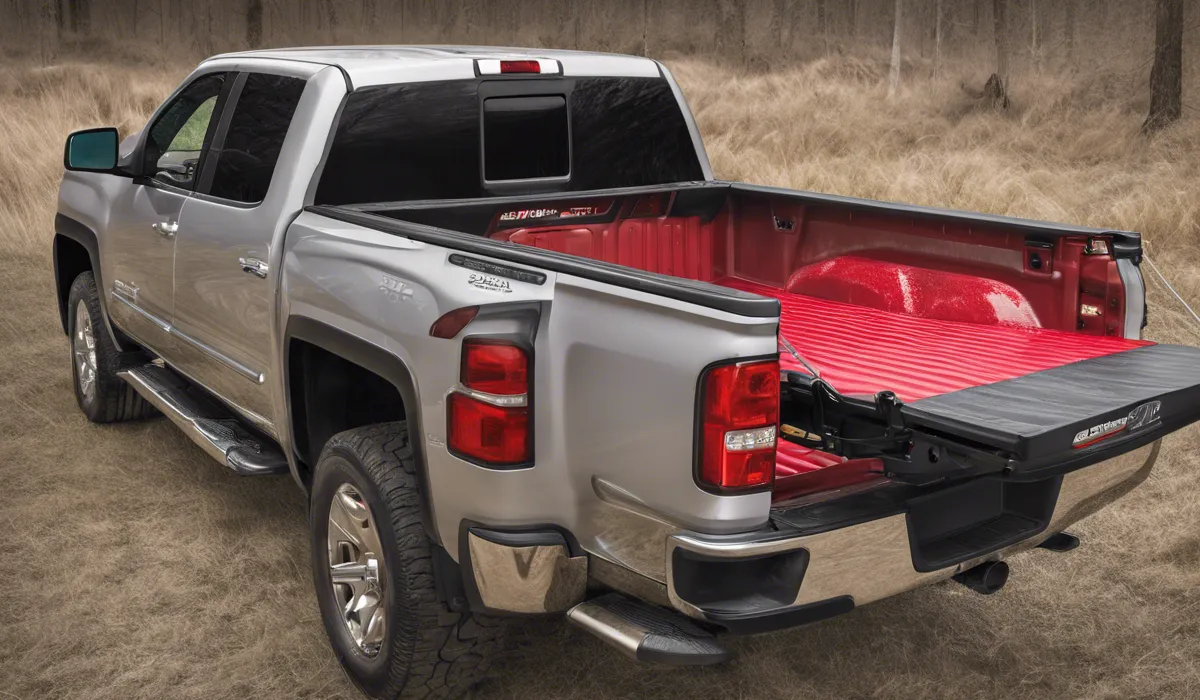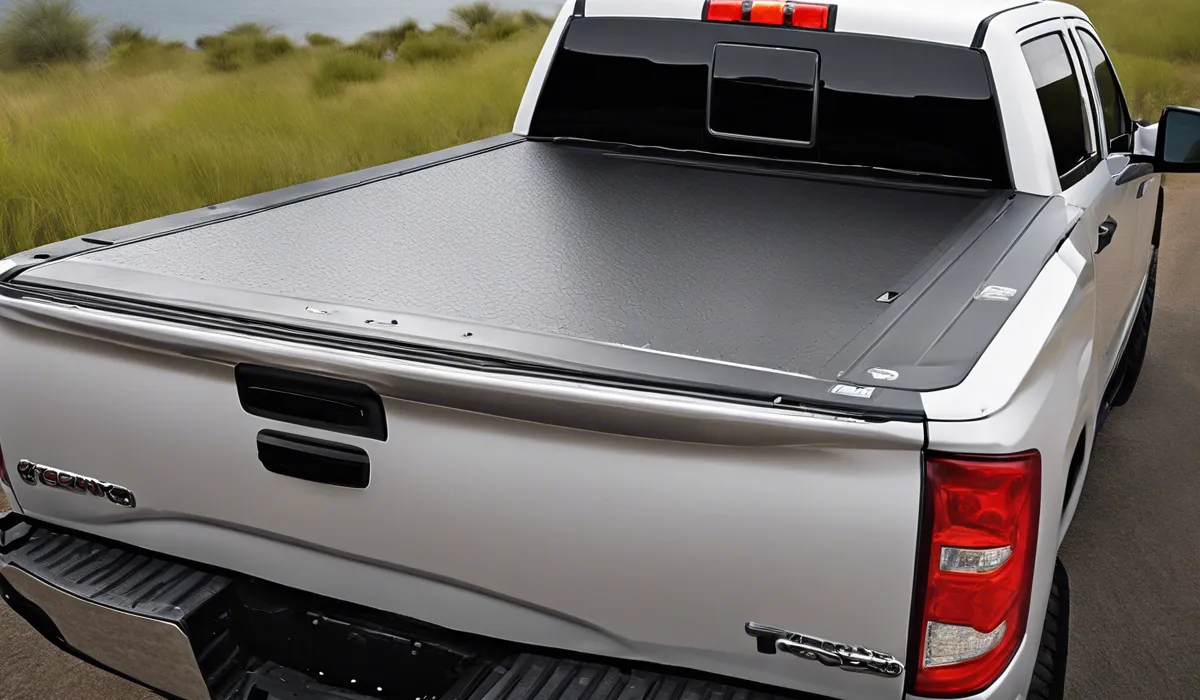To cut a bed liner for a tonneau cover, measure the cover’s dimensions on the liner. Mark cut lines with a marker. Use a steady hand to cut along the lines with a sharp utility knife. Ensure edges are smooth to avoid interference with the cover’s function.
Assessing Your Bed Liner for Customization

Understanding the Types of Bed Liners: Drop-in vs. Spray-on
Before you can start customizing your truck bed for a tonneau cover, it’s essential to understand the type of bed liner you have.
There are mainly two types: drop-in and spray-on.
Drop-in liners are rigid and can be removed or replaced, while spray-on liners provide a permanent protective coating directly on the bed.
Knowing which one you have will determine how you approach the cutting process.
Identifying the Bed Liner Material
Drop-in liners are usually made of a high-density polyethylene or similar plastic, while spray-on liners are a polyurethane or polyurea material.
The material of your bed liner will affect the type of tools and cutting methods you’ll use, so it’s important to identify this upfront.
Measuring Your Truck Bed for the Tonneau Cover
Measure your truck bed carefully to ensure the tonneau cover will fit perfectly.
Take note of the length, width, and any unique features of your truck bed, such as wheel wells or tie-down hooks.
These measurements will guide you in marking where to cut the bed liner.
Considering the Tonneau Cover Type: Hard vs. Soft
The tonneau cover type, whether hard or soft, will affect how you cut your bed liner.
Hard covers may require more precise cuts due to their rigid structure, while soft covers might offer a bit more leeway.
Consider the installation mechanism of the cover as well, since this can influence where and how you need to cut.
Checking for Manufacturer Guidelines or Recommendations
Always check for any guidelines or recommendations from the manufacturer of your bed liner and tonneau cover.
They may provide specific instructions or cautions for cutting and installing.
This information can help you avoid any mistakes that could void warranties or damage your truck.
Preparing for the Cutting Process

Gathering the Required Tools
To cut your bed liner, you will need a utility knife for scoring, a jigsaw for the main cuts, a drill for creating pilot holes, and sandpaper for smoothing edges.
Make sure your tools are in good condition and suitable for the material of your bed liner.
Protecting Yourself and Your Vehicle
Safety should be your top priority.
Wear safety glasses to protect your eyes from debris, gloves to safeguard your hands, and use drop cloths to shield your vehicle from scratches or damage during the cutting process.
Marking the Cutting Lines with Precision
Using the measurements taken earlier, mark the cutting lines on your bed liner with precision.
Use a marker that is visible on your bed liner’s material. Double-check your measurements before cutting to ensure accuracy.
Creating Pilot Holes for Easier Cutting
If you’re using a jigsaw, drilling pilot holes at the corners of your cutting outline can make the process smoother.
These initial holes provide a starting point for the saw blade and can help prevent the material from cracking or tearing.
Securing the Bed Liner to Prevent Movement During Cutting
Ensure the bed liner is securely fastened to your truck bed or a stable work surface to prevent it from shifting while you cut.
This will help you achieve clean, straight lines and avoid any accidental damage.
Executing the Cut and Finishing Touches

Step-by-Step Guide to Cutting the Bed Liner
Begin by scoring the liner with your utility knife along the marked lines.
Next, use the jigsaw to follow the scored lines for the main cuts.
Take your time and maintain a steady hand to ensure the cut is as clean as possible.
Techniques for Smooth Cutting Through Different Materials
For plastic drop-in liners, using a fine-toothed blade on your jigsaw can reduce chipping.
When dealing with spray-on liners, gradual cuts with a sharp utility knife may be more effective.
Always proceed with caution and follow the best practices for the material you are cutting.
Troubleshooting Common Issues During Cutting
If you encounter resistance while cutting, do not force the tool.
Stop and check for obstacles or if the blade needs replacing.
If the bed liner material begins to crack or tear, slow down and reassess your cutting speed and pressure.
Smoothing Out Rough Edges for a Clean Finish
Once the cut is made, use sandpaper to smooth out any rough edges.
This will help the tonneau cover fit snugly and prevent it from snagging or tearing on sharp areas.
Fitting the Tonneau Cover to Test the Cut
After smoothing the edges, place the tonneau cover onto the truck bed to test the fit.
Make any minor adjustments if necessary to ensure the cover is secure and sits flush against the bed liner.
Sealing Any Exposed Areas to Prevent Rust or Damage
If your bed liner was cut, you might have exposed metal.
Seal these areas with a touch-up paint or rust inhibitor to prevent corrosion.
This step is crucial for maintaining the integrity of your truck bed.
Maintenance Tips for the Newly Cut Bed Liner and Tonneau Cover Compatibility
Regularly check the cut areas for signs of wear or damage. Keep the bed liner clean and free of debris to prolong its life and the life of your tonneau cover.
Proper maintenance will ensure both components continue to function together seamlessly.
FAQs About Cutting Bed Liner for Tonneau Cover
What is the first step in cutting a bed liner for a tonneau cover?
The first step is to measure the tonneau cover’s dimensions on the bed liner to determine where cuts need to be made.
How do I mark the bed liner before cutting it for a tonneau cover?
Mark the cut lines on the bed liner using a marker, ensuring they correspond to the tonneau cover’s dimensions.
What tool should I use to cut the bed liner for my tonneau cover?
Use a sharp utility knife with a steady hand to cut along the marked lines on the bed liner.
How can I ensure the cuts on my bed liner are smooth for the tonneau cover?
After cutting the bed liner, check the edges and trim any excess material to ensure they are smooth and will not interfere with the function of the tonneau cover.
Can I cut a bed liner on my own for a tonneau cover, or should a professional do it?
While you can cut the bed liner on your own by following careful measurements and using the right tools, if you’re not confident in doing so, it is advisable to seek professional help to avoid mistakes.
Final Thoughts
To properly cut a bed liner for a tonneau cover, precise measurements and markings are crucial.
Utilize a sharp utility knife for the cutting process to ensure clean edges.
This meticulous approach is essential to guarantee the bed liner conforms to the cover’s dimensions without hindering its functionality.
